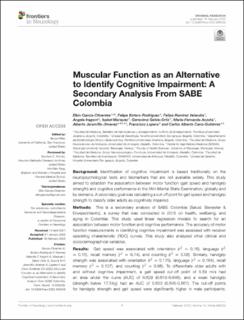| dc.contributor.author | Garcia-Cifuentes, Elkin | |
| dc.contributor.author | Botero-Rodríguez, Felipe | |
| dc.contributor.author | Ramirez Velandia, Felipe | |
| dc.contributor.author | Iragorri, Angela | |
| dc.contributor.author | Marquez, Isabel | |
| dc.contributor.author | Gelvis-Ortiz, Geronimo | |
| dc.contributor.author | Acosta, María-Fernanda | |
| dc.contributor.author | Jaramillo-Jiménez, Alberto | |
| dc.contributor.author | Lopera, Francisco | |
| dc.contributor.author | Cano-Gutiérrez, Carlos Alberto | |
| dc.date.accessioned | 2023-01-11T13:06:37Z | |
| dc.date.available | 2023-01-11T13:06:37Z | |
| dc.date.created | 2022-05-31T13:18:18Z | |
| dc.date.issued | 2022 | |
| dc.identifier.citation | Garcia-Cifuentes, E., Botero-Rodríguez, F., Ramirez Velandia, F., Iragorri, A., Marquez, I., Gelvis, G., ... & Cano-Guitierrez, C. A. (2022). Muscular function as an alternative to identify cognitive impairment: A secondary analysis from SABE Colombia. Frontiers in Neurology, 185. | en_US |
| dc.identifier.issn | 1664-2295 | |
| dc.identifier.uri | https://hdl.handle.net/11250/3042733 | |
| dc.description.abstract | Background: Identification of cognitive impairment is based traditionally on the neuropsychological tests and biomarkers that are not available widely. This study aimed to establish the association between motor function (gait speed and handgrip strength) and cognitive performance in the Mini-Mental State Examination, globally and by domains. A secondary goal was calculating a cut-off point for gait speed and handgrip strength to classify older adults as cognitively impaired.
Methods: This is a secondary analysis of SABE Colombia (Salud, Bienestar & Envejecimiento), a survey that was conducted in 2015 on health, wellbeing, and aging in Colombia. This study used linear regression models to search for an association between motor function and cognitive performance. The accuracy of motor function measurements in identifying cognitive impairment was assessed with receiver operating characteristic (ROC) curves. This study also analyzed other clinical and sociodemographical variables.
Results: Gait speed was associated with orientation (r2 = 0.16), language (r2 = 0.15), recall memory (r2 = 0.14), and counting (r2 = 0.08). Similarly, handgrip strength was associated with orientation (r2 = 0.175), language (r2 = 0.164), recall memory (r2 = 0.137), and counting (r2 = 0.08). To differentiate older adults with and without cognitive impairment, a gait speed cut-off point of 0.59 m/s had an area under the curve (AUC) of 0.629 (0.613–0.646), and a weak handgrip (strength below 17.5 kg) had an AUC of 0.653 (0.645-0.661). The cut-off points for handgrip strength and gait speed were significantly higher in male participants.
Conclusions: Gait speed and handgrip strength are similarly associated with the cognitive performance, exhibiting the most extensive association with orientation and language domains of the Mini-Mental State Examination. Gait speed and handgrip strength can easily be measured by any clinician, and they prove to be useful screening tools to detect cognitive impairment. | en_US |
| dc.language.iso | eng | en_US |
| dc.publisher | Frontiers | en_US |
| dc.rights | Navngivelse 4.0 Internasjonal | * |
| dc.rights.uri | http://creativecommons.org/licenses/by/4.0/deed.no | * |
| dc.title | Muscular Function as an Alternative to Identify Cognitive Impairment: A Secondary Analysis From SABE Colombia | en_US |
| dc.title.alternative | Muscular Function as an Alternative to Identify Cognitive Impairment: A Secondary Analysis From SABE Colombia | en_US |
| dc.type | Peer reviewed | en_US |
| dc.type | Journal article | en_US |
| dc.description.version | publishedVersion | en_US |
| dc.rights.holder | The author | en_US |
| dc.subject.nsi | VDP::Medisinske Fag: 700 | en_US |
| dc.source.volume | 13 | en_US |
| dc.source.journal | Frontiers in Neurology | en_US |
| dc.identifier.doi | 10.3389/fneur.2022.695253 | |
| dc.identifier.cristin | 2028425 | |
| cristin.ispublished | true | |
| cristin.fulltext | original | |
| cristin.qualitycode | 1 | |

